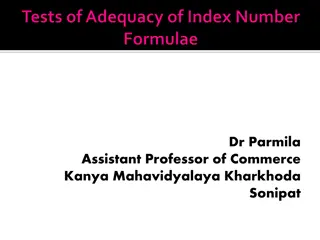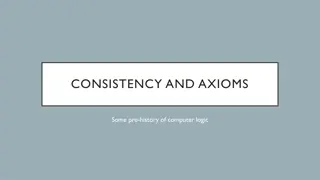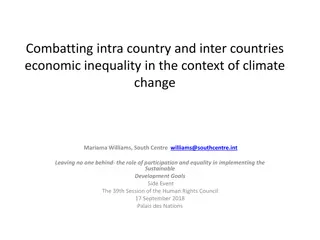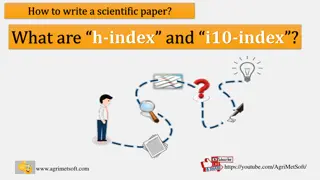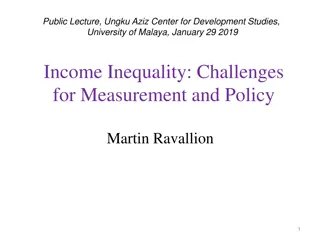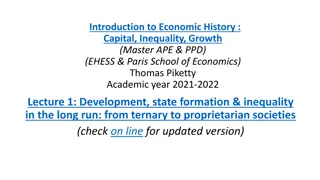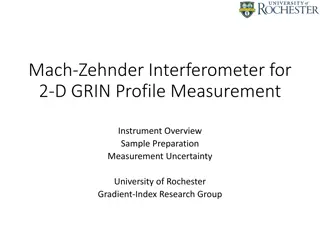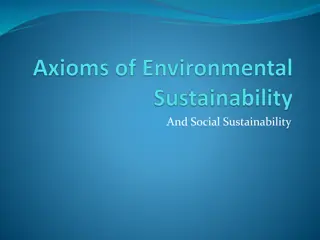Understanding Inequality: A Dive into the Gini Index and Axioms of Measurement
Exploring the core concepts of inequality measurement, this content delves into the essential properties a measure of inequality should have, including the five standard axioms. It discusses the Gini index in detail, elucidating its formula and graphical representation. An informative guide for comprehending inequality metrics.
Download Presentation

Please find below an Image/Link to download the presentation.
The content on the website is provided AS IS for your information and personal use only. It may not be sold, licensed, or shared on other websites without obtaining consent from the author. Download presentation by click this link. If you encounter any issues during the download, it is possible that the publisher has removed the file from their server.
E N D
Presentation Transcript
Georgetown University ECON 156: Poverty and Inequality Lecture notes to accompany Ravallion sThe Economics of Poverty. Part 2: Measurement 2 Chapter 5 EOP Martin Ravallion
5. Measuring inequality (EOP Ch.5) 2
What properties should a measure of inequality have? Five standard axioms (Review Box 5.3 of EOP) Axiom 1: Anonymity (or Symmetry): it does not matter who has which income level. If we shuffle the incomes around then inequality is unchanged. Axiom 2: The Transfer Principle: transferring income from the poor to the rich must increase inequality. Axiom 3: Income Scale Independence: multiplying all incomes by a constant does no change the measure of inequality. 3
Five axioms cont., Axiom 4: Population replication independence; simply replicating the original population cannot increase inequality. Axiom 5: Decomposability: total inequality is the sum of between-group and within-group components. 4
Understanding the Gini index (also called Gini coefficient) How much inequality between (say) three people? We know each of their incomes (or whatever variable we are using). So we can easily calculate all the gaps between their incomes. To assure scale independence we need to divide by the mean (making this a relative inequality measure). The Gini index is based on the average of all these normalized gaps. 5
Formula for the Gini index n n 1 = i = j = Gini y y i j 2 2 n y 1 1 = half the average difference between all pairs of incomes, normalized by the mean. y1-y2 y1-y3 y1-y1 y2-y1 y2-y2 y2-y3 n=3 y3-y1 y3-y2 y3-y3 y1 y2 y3 Note: Gini index satisfies Axioms 1-4 but not 5 6
Gini index graphically Gini index = area between Lorenz Curve (L(p)) and diagonal as proportion of area under the diagonal Figura 2. Brasil 1981-1995: Curvas de Lorenz dedeLorenz lLLorenz deLorenz Curves 100 90 80 70 Gini index=A/(A+B) Renda Acumulada % 60 1981 50 Area A 1990 1995 40 30 Area B 20 10 0 0 10 20 30 40 50 60 70 80 90 100 Popula o Acumulada % Note: Gini index=2 times Area A when the Lorenz Curve is scaled in fractions rather than % 7
Software for calculating Gini index Gini calculator (Buck Shlegeris); very easy to use; just enter your numbers, separated by commas. Also gives you the frequency distribution and Lorenz curve When you have a large data set and/or you are doing other calculations it is better to use a standard statistical software package like Stata. Try the Stata command: ssc describe fastgini Note: if we ask this in an exam question you will only be asked to calculate Gini index for a few easy numbers. We only test your understanding of the concept. 8
Examples: (1,2,x) Suppose that the distribution of income is (1,2,3). Then the Gini index is: 1 ( ) 2 1 ( + + = x + + ) 1 + ) 1 2 x ( 2 = . 0 22 Gini 2 3 2 Mean=2 N=3 (squared) The Gini index in the US is 0.49 (2018). Think of this as three incomes (1,2,x). What would x have to be to get a Gini index of 0.49? Answer: x=12. The Gini index for (1,2,12) is 0.49. + ) 1 2 9 G ( 2 x = = Note: the Gini index for the distribution (1,2,x) is implying that for G< 2/3. ) 3 + x x G 2 3 G ( 3 9
Example: World Gini index The world Gini index is about 0.65. Think of this as three incomes (1,2,x). What is x to get a Gini index of 0.65? The answer: x=157! The Gini index for (1,2,157) is 0.65. Income per capita ($ per day) More realistic version: In $/day: (0.75, 1, 1.5, 2, 2.5, 3.5, 5, 9, 20, 50); this gives Gini=0.65. 60 50 40 30 20 10 0 1 2 3 4 5 6 7 8 9 10 10
A common mistake about the maximum Gini index It is often said that the Gini index is 1 whenever the richest person has all the income. This is wrong. The index will have some upper bound no greater than unity, but the size of that upper bound depends on specific income distribution. In a population of size N in which the richest person has all the income the Gini index reaches is maximum value given by: 1 1 N Exercise: Verify that the Gini index for an income distribution across two people of (0, x) is 0.5 no matter what the value of x 11
Gini can be insensitive, esp., in small samples! L(p) When inequality is high, the Gini index can be quite unresponsive to change in the incomes of the very poor or very rich. Example: Suppose that the distribution of income is (1,2,157) giving a Gini index of 0.65. Doubling the income of either of the poorest reduces the index to 0.64. While doubling the income of the rich increases the index to 0.66 (its maximum with n=3) p (You can easily check using Gini calculator.) 12
Mean/median Not as popular as Gini, but getting there! See for example the Forbes article on rising inequality in US cities. But this is totally insensitive to (mean-preserving) income transfers on either side of the median. 13
Mean log deviation (MLD) (EOP, Box 5.4) n 1 = i = log( ) MLD n iy 1 This simple measure satisfies all five axioms (including decomposability) (1,2,3): MLD=0.10 (1,2,157): MLD=2.06 14
The standard axioms for an inequality measure are not universally accepted Axiom 1: Anonymity: it does not matter who has which income level. Axiom 2: The (Pigou-Dalton) Transfer Principle: transferring income from the poor to the rich must increase inequality. Axiom 3: Income scale independence: multiplying all incomes by a constant does not change the inequality measure. Axiom 4: Population replication independence; simply replicating the original population cannot increase inequality. Axiom 5: Decomposability: total inequality = inequality between groups + inequality within groups. 15
The standard axioms for an inequality measure are not universally accepted Axiom 1: Anonymity: it does not matter who has which income level. But it does matter in reality! Axiom 2: The (Pigou-Dalton) Transfer Principle: transferring income from the poor to the rich must increase inequality. Axiom 3: Income scale independence: multiplying all incomes by a constant does not change the inequality measure. => Relative inequality measures; but absolute gaps also matter! Axiom 4: Population replication independence; simply replicating the original population cannot increase inequality. Axiom 5: Decomposability: total inequality = inequality between groups + inequality within groups. Group identities may matter more than this allows. 16
Relaxing scale independence: Relative vs. absolute inequality Relative inequality is about ratios; absolute inequality is about differences. State A: two incomes $1,000 and $10,000 per year State B: these rise to $2,000 and $20,000 Ratio is unchanged but the rich can buy 10 times more from the income gains in state B than can the poor Relativist sees no difference; absolutist sees higher inequality in state B. One is not right and the other wrong. Amiel and Cowell found that 40% of (student) participants in experiments view inequality in absolute terms. Whether one thinks about inequality as absolute or relative matters greatly to one s views on the distribution of the gains from economic growth. 17
Class survey: Which has higher inequality? A B A B Neither Relativist Absolutist A&R Relativist Absolutist (1,2,3) (2,4,6) Absolutist A&R Absolutist A&R (1,2,3) (2,3,4) Relativist Relativist A&R A&R A&R (1,2,3) (3,1,2) (Anonymity axiom) (1,2,3) (1,2,4) (2,4,6) (4,8,12) (2,4,6) (4,6,8) (2,4,6) (3,4,5) (Transfer axiom) (2,4,6,10) (3,4,6,9) (Transfer axiom) (2,4,6,10) (1,4,6,11) (Transfer axiom) (2,4,6,10) (2,5,5,10) 18 (Transfer axiom)
Survey results 2020 (N=83) A B A 7% B Neither Relativist 49% Absolutist 52% A&R 89% 1% Relativist 42% Absolutist 51% 13% 2% 2% 36% (1,2,3) (2,4,6) Absolutist 43% 4% 6% A&R 96% Absolutist 49% 5% 2% 2% A&R 96% 24% (1,2,3) (2,3,4) Relativist 45% 5% 2% 8% Relativist 45% A&R 84% A&R 95% 1% A&R 40% (1,2,3) (3,1,2) (1,2,3) (1,2,4) (2,4,6) (4,8,12) (2,4,6) (4,6,8) (2,4,6) (3,4,5) (2,4,6,10) (3,4,6,9) (2,4,6,10) (1,4,6,11) (2,4,6,10) (2,5,5,10) 19
Class survey results: 2014-20 (N=601) Distribution A (1,2,3) Which has higher inequality? A B Absolutist 5% 53% Relativist 43% 7% 3% 5% A and R 3% 95% Absolutist 5% 55% Relativist 46% 9% A and R 90% 3% B Neither Relativist 42% Absolutist 50% A and R 92% 2% Relativist 40% Absolutist 45% 7% (2,4,6) (1,2,3) (2,3,4) (1,2,3) (3,1,2) (1,2,3) (1,2,4) (2,4,6) (4,8,12) (2,4,6) (4,6,8) (2,4,6) (3,4,5) 20
Class survey: Summary Almost all of the class agrees with the anonymity axiom. Virtually all agree with the transfer axiom. Interesting that this is less strong for (2,4,6,10) => (2,5,5,10) Polarization is penalized? Extremes further from the middle. Scale independence is far more contentious: indeed, majority are absolutists. 21
Two Gini indices of inequality Relative Gini index 1 y y j r i = G 2 y y 2 n Key difference: relative Gini is normalized by the current mean Absolute Gini index 1 a = G y y i j 2 2 n 22
Two Gini indices 1988 0.72 2008 0.71 Relative Gini 1 ??? ??? 2?2?? Absolute Gini 0.72 0.90 1 2?2 ? ??? ??? Normalized by a fixed mean Note on the literature: The French economist Serge Kolm called the relative Gini the rightest index and the absolute Gini the leftist index. This related to the debates around the protests in the late 1960s. The students rejected proposals for an equal % increase in all incomes. 23
Relaxing anonymity is harder Consider: State A: two incomes $1,000 and $10,000 per year State B: these are swapped to $10,000 and $1,000 Both relative and absolute inequality is the same. Yet the poorest person in State A has gained enormously, while the richest has become the poorest. Relaxing anonymity typically calls for longitudinal ( panel or retrospective) data observing incomes over time for the same people. 24
Inequality versus poverty (EOP Box 3.5) Consider two income distributions: A: (1,1,1) Everyone would probably agree that B is more unequal. But everyone has a higher income in B than A. If we focus on the income of the poorest then we will prefer B to A; the greater inequality in B has benefited the poor. This is an application of John Rawls difference principle : inequality is acceptable if poorest benefit. Income poverty is lower in B, but inequality is higher. However (as Rawls and Sen emphasized), income is not a complete metric of welfare. B: (2,3,10) 25
What if relative income matters? Suppose that welfare is own income normalized by the mean: The distributions of welfare are then: A: (1,1,1) B: (0.4, 0.6, 2) A now has both lower inequality and lower welfare poverty (for all poverty lines less than 2). More generally, suppose that your welfare is: ) / )( 1 ( + y y y i i yi/ y 1 0 For some critical value of welfare poverty is lower under B. Exercise: Verify that the poorest person is better off in state B as long as 375 . 0 26
Which situation would you prefer? Sate A. Having an annual income of $50,000, while the others earn $25,000. State B. Having an annual income of $100,000, while the others earn $250,000. This was asked of a sample of students and lecturers at Harvard University. Over 50 percent opted for A (Solnick and Hemenway). 27
What do Capuchins monkeys think about fairness? Two monkeys. Each trades a rock for food. One gets cucumber in return for a rock, the other gets grapes. They see each other. Look how the one who gets cucumber reacts (Frans de Waal): https://www.youtube.com/watch?v=gOtlN4pNArk Is this about unequal outcomes or fairness in trade? 28
6. Measuring poverty (EOP Ch.5) 29
Desirable properties of a poverty measure Core axioms 1. Focus: A small change in economic welfare for the non-poor cannot change the measure of poverty 2. Monotonicity: A small increase (decrease) in economic welfare for the poor must reduce (increase) the measure of poverty 3. Sub-group monotonicity: An increase (decrease) in poverty for any sub-group of the population must increase aggregate measure of poverty. 4. Transfer: A small transfer of income from a poor person to someone who is poorer must decrease the measure of poverty (also called weak transfer axiom ) 30
Head-count index q H = n q = no. people deemed poor; n = population size Advantage: easily understood Disadvantages: insensitive to distribution below the poverty line The headcount index fails both the Monotonicity and Transfer Axioms Question: What happens to H if a poor person becomes poorer? 31
Quantile functions Poverty line Large gains to the poor but no change in the headcount index 32
Poverty gap index q z 1 z y = i = i PG n 1 y1,...., yq < z < yq+1, ..., yn Advantages of PG: reflects depth of poverty Disadvantages: insensitive to severity of poverty Example: A: (1, 2, 3, 4) B: (2, 2, 2, 4) Let z = 3. HA= 0.75 = HB; PGA= 0.25 = PGB. The Poverty Gap Index fails the Transfer Axiom Question: How is PG affected by an inequality-increasing redistribution of income amongst the poor? 33
Redistribution amongst the poor, but no change in the poverty-gap index 34
Interpretation of PG The minimum cost of eliminating poverty is to fill all poverty gaps exactly: that costs (z- z)q => perfect targeting. ( z=mean for poor) The maximum cost of eliminating poverty is when we know nothing about incomes: cost= z.n => No targeting (UBI = z). Ratio of minimum cost of eliminating poverty to the maximum cost with no targeting: q z z 1 ( ) = = z H PG zn z Poverty gap index indicates the potential saving to the poverty alleviation budget from using information to target poor people. 35
Dont be fooled by the aggregate poverty gap! Global PG (2013; $1.90) = 3.23% Aggregate poverty gap $160 billion. The conclusion drawn is that it should be easy to eliminate poverty. ..about what the world spends on foreign aid. This entirely ignores all the constraints that confront finely targeted transfers. Imperfect information Incentive to escape poverty Political economy At the other extreme: the cost of a Basic Income of $1.90 a day is about $5,000 billion--over 30 times more. (Of course, the blog post would have lost some of its punch.) 36
Squared poverty gap index 2 q z 1 y = i = i SPG n z 1 The SPG satisfies all five core axioms Example: A = (1, 2, 3, 4) B = (2, 2, 2, 4) z = 3 SPGA = 0.14; SPGB = 0.08 Advantage of SPG: sensitive to differences in both depth and severity of poverty. Disadvantage: difficult to interpret Question: How is SPG affected by an inequality-increasing redistribution of income amongst the poor? 37
Foster-Greer-Thorbecke class of measures P0 = H= Headcount index P1 = PG= Poverty gap index P2 = SPG= Squared poverty gap index q z 1 n z y = i ( 0 ) P = 1 i 38
Individual poverty measures For H every poor person gets the same weight. For PG every poverty gap gets the same weight. For SPG, larger gaps are given higher weight. 1 (H) =0 Individual poverty measure 0 (PG) =1 (SPG) =2 convex income (y) Z 39
The Watts index The Watts index is the mean proportionate poverty gap(counting non-poor as having zero gap) q 1 = i = W ln( / ) P z y i n 1 This satisfies all accepted axioms for poverty measurement (including some we have not covered). 40
A thought experiment: You can make a single small gift. Who should get it? Consider a small transfer payment that is not enough for anyone to escape poverty. You can only give it to one person; who should it be? If you use H as your measure then it does not matter who gets the transfer, even if it goes to the non-poor! If you use PG then you will give it to a poor person, but it does not matter which one! Using SPG or the Watts index you will give it to the poorest person you can find. 41
7. A Rawlsian approach: Monitoring progress in assuring that no one is left behind (EOP, pp. 87-91 and pp. 238-40) 42
The disconnect between how economists measure poverty and public discourse Economists count poor people, possibly with distributional weights. Yet much of the public discourse focuses on living standards of the poorest. 43
The counting vs. Rawlsian approaches The measures so far are examples of the counting approach to poverty measurement. An approach inspired by Rawls would focus instead on the consumption floor the lowest level of living. If the poorest person sees a gain (loss) then (by definition) the consumption floor must rise (fall). (EOP, pp. 238-40) However, if we find that any poverty measure (by the counting approach) shows a decrease that does not tell us that the floor has risen! 44
Same reduction in the poverty count but different implications for the poorest Cumulative % of population Cumulative % of population Rising floor Measure of welfare Measure of welfare Poverty line Poverty line Floor stays put Poorest left behind Same reduction in the incidence of poverty but without leaving the poorest behind 45
Other arguments for studying the floor Rights-based approaches to justice Justice must be concerned with eachcitizen not averages Rights must be secured for all; none left behind. Either we all live in a decent world, or nobody does. George Orwell Mahatma Gandhi s talisman: Recall the face of the poorest and weakest person you have seen and ask if the step you contemplate is going to be any use to them. In setting the new Sustainable Development Goals, it has been argued that: the indicators that track them should be disaggregated to ensure no one is left behind. Social policies also aim to raise the floor above the biological minimum for survival. 46
Anecdotal judgements on the ground often look to the poorest In an article Just a little bit richer the Economist (4/4/15) asked how much China s poor area programs have helped reduce poverty. The article points to a poor village in NE Shanxi that has been left behind: They laugh in unison when asked if they receive subsidies. The arrival of electricity 30 years ago was a vast improvement. But little else has changed in their lives since. 47
Safety net as a consumption floor Statutory minimum wage rates: first appeared in late 19th century in an effort to help raise the consumption floor. Universal Basic Income (UBI)/Basic-income guarantee (BIG): From the 1970s, we started to see arguments in support of a fixed cash transfer to every adult. A firm floor. Social policy as a right of citizenship rather than something to be targeted based on need. e.g., demands for universal health insurance. The ILO calls for a comprehensive Social Protection Floor: nationally defined sets of basic social security guarantees . 48
SSNs attempt to raise the floor The term safety net evokes the idea of some sort of floor, and some of the programs can be interpreted as efforts to raise the floor above some biological level This includes the two largest programs to date: China s Di Bao program aims to assure that no family in urban China falls below a stipulated minimum income. India s National Rural Employment Guarantee Scheme interpretable as an attempt to enforce the minimum wage rate in an informal economy. Raising the floor is a common motivation for SSNs. But is this being achieved in practice? 49
8. Multiple and composite indices of poverty and human development (EOP: Ch.5, Section 5.10) 50


